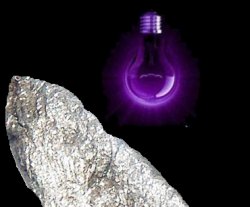
June Editorial

June Editorial
Purifying Europium (a rare earth metal) with UV light |
|
As the name indicates, rare earth metals are indeed rare; and Europium (Eu) is the rarest of them all. Furthermore, like other rare earth metals, Europium does not exist as a free metal in natural form. Instead the metal must be extracted from other minerals. |
|
|
The reason why it is worth extracting this highly-reactive mineral is because it has useful fluorescent properties, and the recent discovery that Europium can be used to store quantum computer data might make it more valuable still. The most notable of the minerals from which Europium must be extracted are - bastnäsite (a carbonate-fluoride mineral), monazite (a reddish-brown phosphate), xenotime (itself a rare earth phosphate mineral) and loparite (a granular, brittle oxide mineral of the perovskite class). Many rare earth elements are found together in these sources, so extraction techniques attempt to harvest them all. One technique, for example, involves first roasting the ore and then applying acidic and basic leaching. The rare earth minerals are then further separated by solvent extractions or ion exchange chromatography. But the bottom line is that all current methods are complex and the yield is poor. Professor Tom Van Gerven from the KU Leuven University Department of Chemical Engineering explains: 'The traditional method dissolves Europium and Yttrium [two rare earth metals of particular interest to his research team] in aqueous acid. An extractant and a solvent are then added to the aqueous liquid, leading to two separate layers known as 'phases': an aqueous layer containing the rare earth metals and a solvent layer with the extractant. When the two layers come into contact, one of the two rare earth metals is extracted to the solvent, while the other rare earth metal remains in the aqueous layer. But this process leaves much to be desired in terms of efficiency and purity: it needs to be repeated dozens of times to recover a high percentage of a particular rare earth metal, and there will still be traces of Yttrium in the Europium-containing liquid and vice versa.' Given that rare earth metals are difficult to get hold of, recycling the metals already extracted is of considerable importance. This is what researchers from the Department of Chemical Engineering at the university have been working on. Early this year KU Leuven chemists discovered a way to separate Europium and Yttrium using UV light rather than traditional solvents. They started not with specialized kit, but by collecting fluorescent lamps and low-energy light bulbs. This is because one of the characteristic properties of Europium and Yttrium (as with other lanthanides) is that they oxidise readily and assume an oxidation state of +3. (The oxidation state, often called the oxidation number, indicates the degree of oxidation by how many electrons are lost.) Because electrons have a negative charge, oxidized metals are usually positively charged when in solution. The researchers discovered that shining UV light onto a solution containing Europium neutralised one positive charge of Europium. This reduced the oxidation state of the Europium to +2. When sulphate is added to the solution, only the Eu+2 reacts with it. This can be precipitated as solid EuS04, leaving the Y+3 in the solution. The advantages of UV light are that it does not leave behind any harmful chemicals in the liquid and that the separation efficiency and purity in synthetic mixtures is very high. More than 95% of the Europium is recovered from the solution. The precipitate itself is 98,5% pure, so it contains hardly any traces of Yttrium. Journal Reference: | |
| _______________________________ | ||||
| Home | | | Shopping | | | Database |
© Biscuit Software 2004-2015
All rights reserved